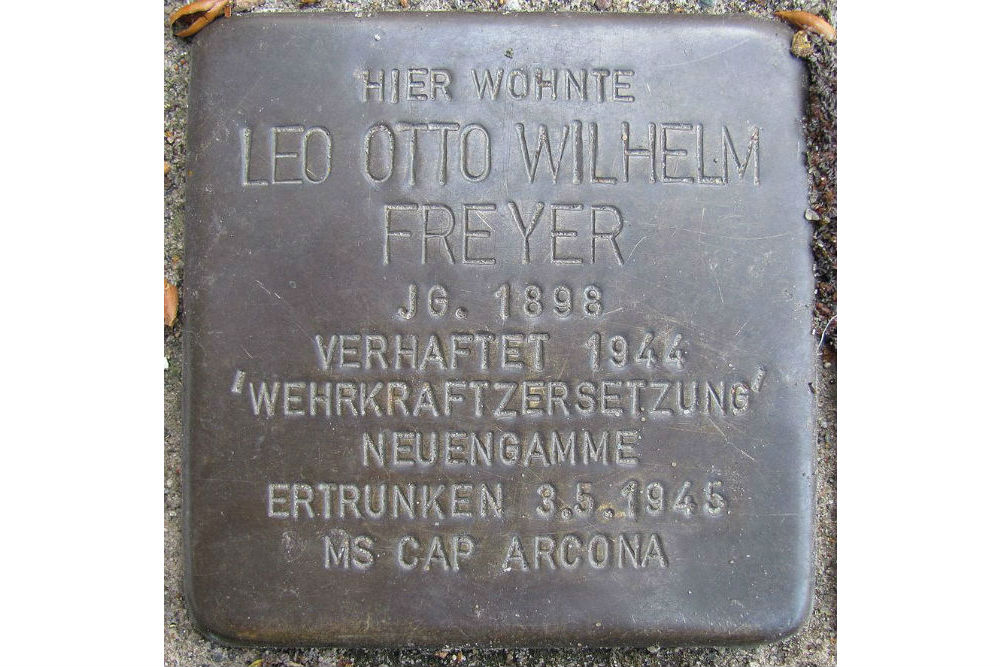Stumbling Stone Mülhäuser Straße 5
This small, brass memorial plaque (Stolperstein or stumbling stone) commemorates:
* Leo Otto Wilhelm Freyer, born 1898, arrested 1944, sedition and defeatism, Neuengamme, drowned 3 May 1945, MS Cap Arcona.
According to Wikipedia, the term Wehrkraftzersetzung -- the reason on the stolperstein for Freyer's arrest -- was used by the Nazis to refer to "undermining military morale" or to "sedition and defeatism."
Leo Otto Wilhelm Freyer spent most of his childhood in Kiel. He moved to Hamburg in the 1930s. In October 1938, he and Anna-Elisabeth Hartmann, a postal assistant, married. They had a daughter, Barbara, born in 1940. He was a painter.
Fryer was conscripted to emergency duty in August 1943 and worked as a guard at the Fuhlsbüttel prison. At some point, a fellow guard and neighbors denounced him.
Although there was evidence of Freyer’s earlier patriotism, Nazi investigators found no evidence of pro-Nazi activity and decided he had acted seditiously. (A 1961 document search led to the conclusion that Fryer never joined the Nazi party.)
In November 1944, he was sentenced to 3 years in prison for treachery. From the Hütten Jail he was transferred on 24 March 1945 to the Neuengamme concentration camp.
When the Nazis emptied the Neuengamme camp in April 1945 before the arrival of the Allies, thousands of prisoners were put on the Cap Arcona, a ship which became an overcrowded concentration camp with no food and no drinking water. The Cap Arcona and several other floating concentration camps were hidden in plain sight among other troop ships. With a goal of keeping the Germans from escaping by boat, the British bombed the ships in the harbor. Approximately 7,000 concentration camp prisoners died by fire or drowning, or were shot by Germans on the shore. Leo Otto Wilhelm Freyer did not survive.
Four days later, the Germans signed an unconditional surrender of all German forces to the Allies.
"Stolpersteine" is an art project for Europe by Gunter Demnig to commemorate victims of National Socialism (Nazism). Stolpersteine (stumbling stones) are small, 10x10cm brass plaques placed in the pavement in front of the last voluntary residence of (mostly Jewish) victims who were murdered by the Nazis. Each plaque is engraved with the victim’s name, date of birth, and place (mostly a concentration camp) and date of death. By doing this, Gunter Demnig gives an individual memorial to each victim. One stone, one name, one person. He cites the Talmud: "A human being is forgotten only when his or her name is forgotten."
For more information and photos about the Cap Arcona, please see Floating concentration camps in the Bay of Lübeck.
Do you have more information about this location? Inform us!
Source
- Text: Fedor de Vries & Anne Palmer
- Photos: NordNordWest
- Stolpersteine in Hamburg: Leo Otto Wilhelm Freyer
- Stolpersteine.eu
Nearby
Museum
- Bunkermuseum Hamburg-Hamm - Hamburg-Hamm
- Fuhlsbüttel Concentration Camp Hamburg - Hamburg-Ohlsdorf
- Museum Ernst Thälmann - Hamburg-Eppendorf
Point of interest
- Air-Raid Shelter Drosselstraße - Hamburg-Barmbek
- Air-Raid Shelter Barmbek Station - Hamburg-Barmbek
- Air-Raid Shelter Tonistraße - Hamburg-Eilbek
Monument
- Memorial Synagogue Wandsbek - Hamburg-Wandsbek
- Rose-Garden Elfriede Lohse-Wächtler - Hamburg-Eilbek
- Franco-Prussian War Memorial Wandsbek - Hamburg-Wandsbek
Cemetery
- Siege Cemetery Hamburg - Hamburg-Barmbek-Süd
- Graves of Freedom Fighters Jewish Cemetery Friedhof Ohlsdorf Hamburg - Hamburg-Ohlsdorf
- German Jewish War Graves Jüdischer Friedhof Ohlsdorf Hamburg - Hamburg-Ohlsdorf
Remembrance Stone
- Stumbling Stone Haderslebener Straße 11 - Hamburg-Dulsberg
- Stumbling Stone Nordschleswiger Straße 48 - Hamburg-Dulsberg
- Stumbling Stone Haderslebener Straße 9 - Hamburg-Dulsberg




